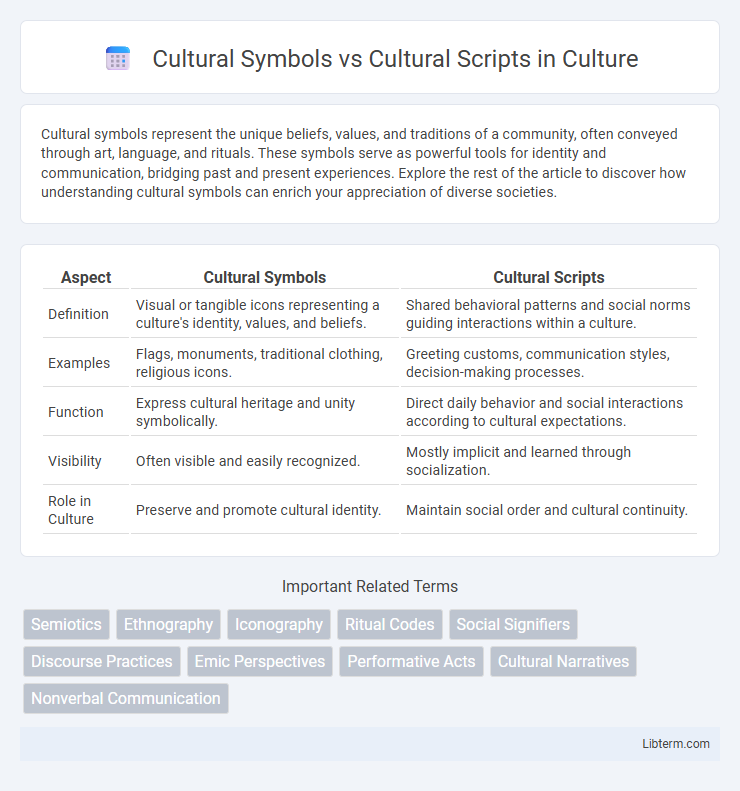Cultural symbols represent the unique beliefs, values, and traditions of a community, often conveyed through art, language, and rituals. These symbols serve as powerful tools for identity and communication, bridging past and present experiences. Explore the rest of the article to discover how understanding cultural symbols can enrich your appreciation of diverse societies.
Table of Comparison
| Aspect | Cultural Symbols | Cultural Scripts |
|---|---|---|
| Definition | Visual or tangible icons representing a culture's identity, values, and beliefs. | Shared behavioral patterns and social norms guiding interactions within a culture. |
| Examples | Flags, monuments, traditional clothing, religious icons. | Greeting customs, communication styles, decision-making processes. |
| Function | Express cultural heritage and unity symbolically. | Direct daily behavior and social interactions according to cultural expectations. |
| Visibility | Often visible and easily recognized. | Mostly implicit and learned through socialization. |
| Role in Culture | Preserve and promote cultural identity. | Maintain social order and cultural continuity. |
Defining Cultural Symbols
Cultural symbols are tangible or intangible representations that carry specific meanings within a particular society, such as flags, rituals, or language, which evoke shared identities and values. These symbols serve as powerful tools for communication and social cohesion, encapsulating historical narratives and collective experiences unique to a community. Defining cultural symbols involves understanding their role in expressing cultural norms and reinforcing group identity across generations.
Understanding Cultural Scripts
Cultural scripts are mental frameworks guiding behaviors, communication, and interpretation within a cultural context, often shaping social interactions and expectations. Unlike cultural symbols, which are tangible or visual representations such as flags or logos, cultural scripts function as implicit norms and shared understandings that influence how individuals act and respond in various situations. Understanding cultural scripts enhances cross-cultural communication by revealing deep-seated values and habitual practices that govern everyday conduct in diverse societies.
Key Differences Between Symbols and Scripts
Cultural symbols are tangible or visual representations that embody specific meanings within a culture, such as flags, logos, or traditional garments, while cultural scripts are the shared, implicit guidelines or norms that dictate social behaviors and interactions in that culture. Symbols communicate identity and values through imagery and artifacts, whereas scripts shape conduct and expectations through patterns of language, customs, and rituals. The key differences lie in symbols' concrete, representational nature versus scripts' abstract, procedural influence on cultural behavior.
Historical Evolution of Cultural Symbols
Cultural symbols have evolved historically as tangible or visual representations embodying collective identity, values, and beliefs, often originating from ancient rituals, myths, and significant societal events. This evolution reflects changes in social dynamics, technological advancements, and intercultural exchanges, leading to layered meanings that transcend their initial contexts. Unlike cultural scripts, which are behavioral norms and patterns, cultural symbols serve as enduring markers that encapsulate historical narratives and cultural heritage across generations.
The Role of Scripts in Social Interactions
Cultural scripts are structured mental frameworks that guide social behaviors and interactions, shaping expectations and communication patterns within a community. Unlike cultural symbols, which represent shared meanings through objects or signs, scripts provide dynamic templates for interpreting social roles, rituals, and conversational norms. These scripts facilitate smooth social interactions by promoting predictability and coherence in behavior, ensuring that members of a culture respond appropriately in various social contexts.
Examples of Cultural Symbols in Everyday Life
Cultural symbols such as flags, religious icons, and traditional clothing serve as powerful representations of identity and heritage in everyday life. For example, the American flag symbolizes patriotism and national unity, while the kimono in Japan reflects cultural history and social status. These symbols convey complex meanings and values that shape social interactions and cultural understanding across diverse communities.
Cultural Scripts: Shaping Behavior and Expectations
Cultural scripts are implicit guidelines ingrained in social groups that dictate appropriate behaviors, communication styles, and emotional expressions based on cultural context. These mental frameworks shape individuals' expectations and interactions by providing structured norms that influence social conduct and decision-making. Unlike cultural symbols, which represent shared meanings through objects or icons, cultural scripts operate as dynamic, unspoken rules that govern everyday behavior and help maintain social cohesion.
The Intersection of Symbols and Scripts
Cultural symbols are tangible or intangible signs that carry specific meanings within a culture, such as flags or rituals, while cultural scripts are the unwritten social norms and behaviors guiding how individuals interpret and use these symbols. At the intersection of symbols and scripts, cultural understanding emerges as symbols gain meaning through the shared scripts that dictate appropriate contexts and responses. This interplay shapes communication and identity within societies, influencing how cultural narratives are maintained and transformed over time.
Impact on Cross-Cultural Communication
Cultural symbols, such as flags, language, and rituals, convey deep meanings that influence individuals' perceptions and interactions across diverse cultures, shaping immediate emotional responses and identity recognition. Cultural scripts comprise the unwritten rules and behaviors governing social conduct and communication patterns, guiding individuals on appropriate actions and interpretations within specific cultural contexts. Misalignment or misunderstanding of these symbols and scripts often leads to communication barriers, misinterpretations, and conflicts in cross-cultural exchanges, emphasizing the importance of cultural competence and awareness in global interactions.
Navigating Misunderstandings in a Globalized World
Cultural symbols such as flags, gestures, or traditional attire communicate identity and values, while cultural scripts encompass the implicit behavioral norms and social expectations within a culture. Misunderstandings arise when individuals interpret symbols through the lens of their own cultural scripts, leading to miscommunication in global interactions. Effective cross-cultural competence requires recognizing these distinctions and contextualizing symbols within their native cultural scripts to foster mutual understanding.
Cultural Symbols Infographic

 libterm.com
libterm.com